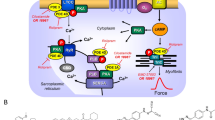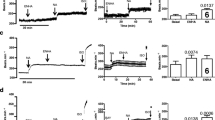Summary
The chronotropic cardiac effects of alinidine were studied in the conscious dog with chronic atrioventricular block. Alinidine at 0.5–4 mg/kg, i. e., at plasma concentrations between 42 ± 2 and 1625 ± 371 ng/ml, initially increased atrial rate dose-dependently. This effect fell off rapidly, but atrial bradycardia was never observed. After atropine and pindolol, which raised basal atrial rate, alinidine (2 mg/kg) decreased atrial rate, whereas after phenoxybenzamine, yohimbine or phentolamine, it produced atrial effects identical to those observed under basal conditions, i. e., initial tachycardia and no bradycardia. Alinidine dose-relatedly decreased ventricular rate. None of the pretreatments modified the maximal ventricular bradycardia, but interestingly after pindolol or yohimbine this effect developed more rapidly (maximal bradycardia between 3 and 5 against 30 min) and then declined progressively. Alinidine did not modify mean blood pressure at any dose. After atropine, phenoxybenzamine or phentolamine, alinidine remained without effect on mean blood pressure, but after pindolol or yohimbine, a hypotensive effect appeared concomitantly with the reduction of the ventricular bradycardia. These results show that the initial atrial cardioacceleration due to alinidine results from a direct vagolytic action of this drug and that the absence of atrial bradycardia results from buffering by the vagolytic effect and/or a relatively low basal atrial rate. They also suggest that the ventricular brädycardia does not involve either the muscarinic cholinoceptors or the alpha- or beta-adrenoceptors, though the results obtained after pindolol or yohimbine suggest possible involvement of a fall in sympathetic tone by stimulation of presynaptic or central alpha2-adrenoceptors, particularly in the persistence of the bradycardic effect. Overall, these results indicate that alinidine exerts, in the conscious dog, chronotropic effects that depend closely on basal heart rate, and so on the control that the autonomic nervous system exerts on the heart. This explains why under certain conditions — relatively low heart rate — alinidine may have a cardioaccelerator effect.
Similar content being viewed by others
References
Arndts D, Förster HJ (1981) New aspects in the metabolism of alinidine in man. Eur J Drug Metab Pharmacokin 6:313–315
Bloomberg ML, Bergman H, Sheiner NM (1970) A technique of chronic arterial catheterization in dogs. J Cardiovasc Surg (Torino) 11:137–140
Boucher M, Duchêne-Marullaz P (1980) Acebutolol, metoprolol and propranolol in conscious dogs with chronic heart-block: chronotropic effects and relation between depression of ventricular activity and beta-adrenoceptor blocking potency. Br J Pharmacol 70:335–340
Boucher M, Duchêne-Marullaz P (1985) Methods for producing experimental complete atrioventricular block in dogs. J Pharmacol Meth 13:95–107
Boucher M, Duchêne-Marullaz P, Lavarenne J (1979) Catecholamines and cardiac rhythms in the unanesthetized dog with chronic AV block. Am J Physiol 237:H10-H17
Boucher M, Dubray C, Duchêne-Marullaz P (1982) Long-term observation of atrial and ventricular rates in the unaesthetized dog with complete atrioventricular block. Pflügers Arch 395:341–343
Boucher M, Dubray C, Duchêne-Marullaz P (1984a) Dopamine in the conscious dog with chronic heart-block. Mechanisms of chronotropic cardiac effects. Naunyn-Schmiedeberg's Arch Pharmacol 326:148–154
Boucher M, Dubray C, Duchêne-Marullaz P (1984b) Chronotropic effects of pindolol. Relation between ventricular effects and control resting ventricular rate values in conscious dogs with chronic A-V block. Naunyn-Schmiedeberg's Arch Pharmacol 325:183–185
Chassaing C, Duchêne-Marullaz P (1981) In vitro and in vivo activities of anticholinergics on the cholinoceptors of the cardic pacemaker cells. Eur J Pharmacol 72:165–172
Chassaing C, Godeneche D, Boucher M, Duchêne-Marullaz P (1979) A comparison of changes in atropine-induced tachycardia and atropine concentration in conscious dogs. Eur J Pharmaco1 58:433–441
Cox RH (1972) Influence of pentobarbital anesthesia on cardiovascular function in trained dogs. Am J Physiol 223:651–659
Duchêne-Marullaz P, Combre A, Lavarenne J, Lapalus P, Schaff G (1975) Comparaison des effets du propranolol, de l'alprénolol, du pindolol et du practolol sur les rythmes cardiaques de chiens non narcosés en dissociation auriculoventriculaire chronique. J Pharmaco1 6:441–452
Fredericq L (1904) L'atriotomie temporaire, procédé nouveau d'exploration des fonctions du coeur. Arch Int Physiol 1:83–85
Hageman GR, Neely BH, Urthaler F, James TN (1985) Negative chronotropic and parasymphatolytic effects of alinidine on canine sinus node and AV junction. Am J Physiol 248:H324-H330
Johansson P (1984) Alpha-adrenoceptors: recent developement and some comparative aspects. Comp Biochem Physiol 780:253–261
Kawada M, Satoh K, Taira N (1984) Selectivity of alinidine, a bradycardic agent, for SA nodal automaticity versus other cardiac activities in isolated, blood-perfused dog-heart preparations. Arch Int Pharmacodyn 272:88–102
Kobinger W, Lillie C, Pichler L (1979a) N-allyl-derivative of clonidine, a substance with specific bradycardic action at a cardiac site. Naunyn-Schmiedeberg's Arch Pharmacol 306: 255–262
Kobinger W, Lillie C, Pichler L (1979b) Cardiovascular actions of N-allyl-clonidine (ST 567), a substance with specific bradycardic action. Eur J Pharmacol 58:141–150
Li JH, Boucher M, Carpentier A, Duchêne-Marullaz P (1986) Propafenone in the conscious dog with chronic atrioventricular block: Mechanisms of chronotropic cardiac effects and plasma concentration-response relationships. J Cardiovasc Pharmacol 8:885–891
Manders WT, Vatner SF (1976) Effects of sodium pentobarbital anesthesia on left ventricular function and distribution of cardiac output in dogs, with particular reference to the mechanism for tachycardia. Circ Res 39:512–517
Millar JS, Vaughan Williams EM (1981) Pacemaker selectivity: influence on rabbit atria of ionic environment and of alinidine, a possible anion antagonist. Cardiovasc Res 15:335–350
Minneman KP (1983) Phenoxybenzamine is more potent in inactivating alpha1- than alpha2-adrenergic receptor binding sites. Eur J Pharmacol 94:171–174
Opthof T, Duivenvoorden JJ, Vanginneken ACG, Jongsma HJ, Bouman LN (1986) Electrophysiological effects of alinidine (ST 567) on sinoatrial node fibres in the rabbit heart. Cardiovasc Res 20:727–739
Pichler L (1982) Effect of alinidine (ST 567) on sympathetic and vagal activities. Arch Int Pharmacodyn 255:162–167
Reynolds RD, Di Salvo J (1978) Effects of dl-propranolol on atrial and ventricular rates in unanesthetized atrioventricular blocked dogs. J Pharmacol Exp Ther 205:374–381
Rigel DF, Lipson D, Katona PG (1984) Excess tachycardia: heart rate after antimuscarinic agents in conscious dogs. Am J Physiol 246:168–173
Robinson JL, Farr WC, Grupp G (1973) Atrial rate response to ventricular pacing in the unanesthetized A-V blocked dog. Am J Physio1 224:40–45
Ruffolo RR Jr (1985) Distribution and function of peripheral alpha-adrenoceptors in the cardiovascular system. Pharmacol Biochem Behav 22:827–833
Satoh H, Hashimoto K (1986) Electrophysiological study of alinidine in voltage clamped rabbit sine-atria, node cells. Eur J Pharmacol 121:211–219
Seyama I (1979) Characteristics of the anion channel in the sino-atrial node cell of the rabbit. J Physiol (Lond) 294:447–460
Siegl PKS, Wenger HC, Sweet CS (1984) Comparison of cardiovascular responses to the bradycardic drugs, alinidine, AQ-A39, and mixidine in the anesthetized dog. J Cardiovasc Pharmacol 6:565–574
Traunecker W, Walland A (1980) Haemodynamic and electrophysiologic actions of alinidine in the dog. Arch Int Pharmacodyn 244:58–72
Tritthart HA, Windisch H, Heuberger S (1981) The effects of the bradycardia-producing compound alinidine on action potentials and tension development in cardiac fibres. Naunyn-Schmiedeberg's Arch Pharmacol 316:172–177
Wiegand UW, Meinertz T, Kasper W, Jähnchen E (1981) Determination of alinidine in human plasma by high-performance liquid chromatography. J Chromatogr 223:238–242
Author information
Authors and Affiliations
Additional information
Technical assistance
Send offprint requests to M. Boucher at the above address
Rights and permissions
About this article
Cite this article
Boucher, M., Chapuy, E., Lefebvre, M.A. et al. Mechanisms of chronotropic cardiac effects of alinidine and plasma concentration-response relationships in the conscious dog with chronic atrioventricular block. Naunyn-Schmiedeberg's Arch Pharmacol 339, 630–637 (1989). https://doi.org/10.1007/BF00168655
Received:
Accepted:
Issue Date:
DOI: https://doi.org/10.1007/BF00168655




